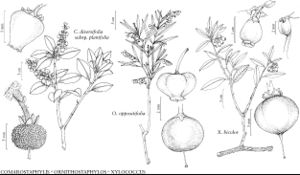Difference between revisions of "Xylococcus"
Trans. Amer. Philos. Soc., n. s. 8: 258. 1842 ,.
FNA>Volume Importer |
FNA>Volume Importer |
(No difference)
| |
Revision as of 20:30, 24 September 2019
Shrubs, burled; bark reddish, shredding. Stems spreading to erect, branching, cinereous-tomentulose. Leaves usually alternate, rarely opposite, bifacial; blade narrowly elliptic, elliptic, or ovate, coriaceous, margins entire, strongly revolute, abaxial surface densely white- to cinereous-tomentose, adaxial glabrous. Inflorescences dense panicles, 4–12-flowered, (axis cinereous-tomentulose). Flowers bisexual; sepals persistent, (4–)5, connate basally, ovate; petals (4–)5, connate 1/2+ their lengths, white or pink (rose), corolla urceolate; stamens (8–)10, included; anthers with 2 awns, dehiscent by slitlike pores; filaments elongate, dilated near base, (hairy); ovary (4–)5-locular, (hairy); stigma capitate. Drupes red to almost black, subglobose, dry, with smooth exocarp and thin pulpy layer; pyrenes 5, connate into smooth, solid stone. Seeds 5, connate. x = 13.
Distribution
s Calif., nw Mexico.
Discussion
Species 1: s California, nw Mexico.
Species 1
Selected References
None.
